Epson ActionLaser 1100 Reference Guide
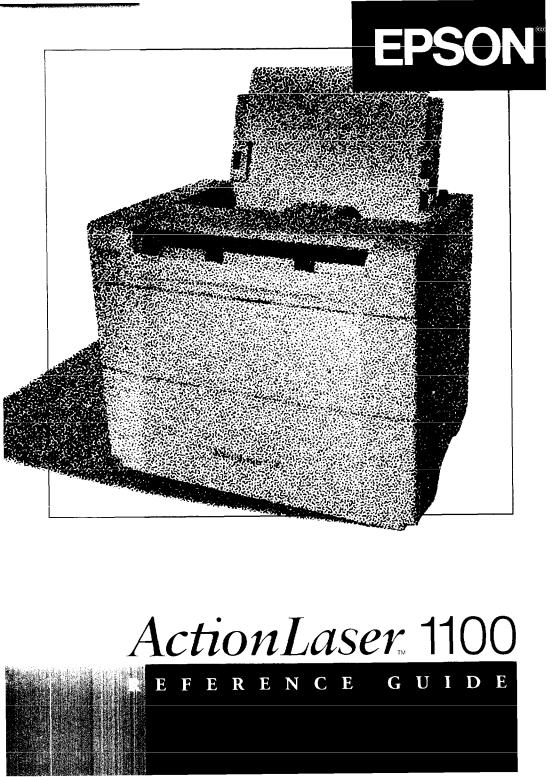

FCC COMPLIANCE STATEMENT
FOR AMERICAN USERS
This equipment has been tested and found to comply with the limits for a class B digital device, pursuant to Part 15 of the FCC Rules. These limits are designed to provide reasonable protection against harmful interference in a residential installation. This equipment generates, uses and can radiate radio frequency energy and, if not installed and used in accordance with the instructions, may cause harmful interference to radio or television reception. However, there is no guarantee that interference will not occur in a particular installation. If this equipment does cause interference to radio and television reception, which can be determined by turning the equipment off and on, the user is encouraged to try to correct the interference by one or more of the following measures:
Reorient or relocate the receiving antenna
Increase the separation between the equipment and receiver
Connect the equipment into an outlet on a circuit different from that to which the receiver is connected
Consult the dealer or an experienced radio/TV technician for help.
WARNING
The connection of a non-shielded equipment interface cable to this equipment will invalidate the FCC Certification of this device and may cause interference levels which exceed the limits established by the FCC for this equipment. It is the responsibility of the user to obtain and use a shielded equipment interface cable with this device. If this equipment has more than one interface connector, do not leave cables connected to unused interfaces.
Changes or modifications not expressly approved by Epson America, Inc., could void the user’s authority to operate the equipment.
FOR CANADIAN USERS
This digital apparatus does not exceed the Class B limits for radio noise emissions from digital apparatus as set out in the radio interference regulations of the Canadian Department of Communications.
Le présent appareil numérique n’émet pas de bruits radioélectriques dépassant les limites applicables aux appareils numériques de Classe B prescrites dans le réglement sur le brouillage radioélectrique édicté par le Ministére des Communications du Canada.


All rights reserved. No part of this publication may be reproduced, stored in a retrieval system, or transmitted in any form or by any means, electronic, mechanical, photocopying, recording, or otherwise, without the prior written permission of Seiko Epson Corporation. No patent liability is assumed with respect to the use of the information contained herein. Neither is any liability assumed for damages resulting from the use of the information contained herein.
Neither Seiko Epson Corporation nor its affiliates shall be liable to the purchaser of this product or third parties for damages, losses, costs, or expenses incurred by purchaser or third parties as a result of: accident, misuse, or abuse of this product or unauthorized modifications, repairs, or alterations to this product.
Seiko Epson Corporation and its affiliates shall not be liable against any damages or problems arising from the use of any options or any consumable products other than those designated as Original EPSON Products or EPSON Approved Products by Seiko Epson Corporation.
ActionLaser is a trademark of Epson America, Inc.
EPSON Connection is a service mark of Epson America, Inc.
EPSON is a registered trademark of Seiko Epson Corporation.
Hewlett-Packard, HP, PCL, and LaserJet are registered trademarks of Hewlett-Packard Company.
CG and Intellifont are registered trademarks and CG Times, based on Times New Roman under license from The Monotype Corporation, are products of Miles Inc.
Univers is a registered Trademark of Linotype AG and/or its subsidiaries. Agfa and the Agfa Rhombus are registered trademarks of Agfa-Geveart, AG. Universal Font Scaling Technology (UFST) is a trademark of Miles Inc.
General Notice: Other product names used herein are for identification purposes only and may be trademarks of their respective companies. EPSON disclaims any and all rights in those marks.
The Energy Star emblem does not represent EPA endorsement of any product or service.
Manual is copyright © 1994 by Epson America, Inc., Torrance, California, USA Software copyrights
©Copyright, HostPanel,TM 1993/1994, Destiny Technology Corporation, Ver. 1.0
©Copyright, WinPanel,TM 1993/1994, Destiny Technology Corporation, Ver. 1.0
© |
Portions Copyright, WinPanelTM 5 Driver, 1994, Destiny Technology Corporation, Ver. 1.0 |
||
© |
Copyright, |
LaserAct,® |
1990/1994, Destiny Technology Corporation, Ver. 5.0 |
© |
Copyright, |
1985/1990, |
Microsoft Corporation |
©Copyright, 1989/1992, Hewlett-Packard Company
©Copyright, 1988/1989, Aldus Co.
ii

Contents
Getting Started |
|
Where to Get Help for U.S. and Canadian Users . . . . . . . . |
1 |
CompuServe On-line Support . . . . . . . . . . . . . . . . |
2 |
Safety Information . . . . . . . . . . . . . . . . . . . . . . . . . |
3 |
Laser safety . . . . . . . . . . . . . . . . . . . . . . . . . . . |
3 |
CDRH regulations . . . . . . . . . . . . . . . . . . . . . . . |
3 |
Internal laser radiation . . . . . . . . . . . . . . . . . . . . |
4 |
Ozone emission . . . . . . . . . . . . . . . . . . . . . . . . |
4 |
Laser Printer Precautions . . . . . . . . . . . . . . . . . . . . . . |
5 |
Important Safety Instructions . . . . . . . . . . . . . . . . . . . |
7 |
About this Guide . . . . . . . . . . . . . . . . . . . . . . . . . . |
8 |
Chapter 1 Using Your Printer |
|
About Your Printer . . . . . . . . . . . . . . . . . . . . . . . . . |
1-2 |
Features . . . . . . . . . . . . . . . . . . . . . . . . . . . . . |
1-2 |
Adjusting the Power Save Mode . . . . . . . . . . . . . . . . . |
1-4 |
Monitoring the Printer Status . . . . . . . . . . . . . . . . . . . |
1-5 |
Front panel lights . . . . . . . . . . . . . . . . . . . . . . . |
1-5 |
EPSON Control Panel for Windows . . . . . . . . . . . . |
1-7 |
Paper Handling . . . . . . . . . . . . . . . . . . . . . . . . . . . |
1-8 |
Loading paper . . . . . . . . . . . . . . . . . . . . . . . . . |
1-8 |
Choosing paper . . . . . . . . . . . . . . . . . . . . . . . . |
1-9 |
Printing on special paper . . . . . . . . . . . . . . . . . . . |
1-10 |
Fonts . . . . . . . . . . . . . . . . . . . . . . . . . . . . . . . . . |
1-11 |
i i i

Chapter 2 Changing the Printer Settings
Changing the Printer Settings .............................. |
2-2 |
|
Accessing Printer Driver Setting in Windows .................... |
2-3 |
|
Print Driver Settings ......................................................... |
2-4 |
|
|
Print settings ............................................................... |
2-4 |
|
Option settings .............................................................. |
2-9 |
|
Font Manager ............................................................... |
2-12 |
Chapter 3 Troubleshooting |
|
|
|
Resetting the Printer . . . . . . . . . . . . . . . . . . . . . . . . |
3 - 2 |
|
General Problems . . . . . . . . . . . . . . . . . . . . . . . . . . |
. 3-2 |
|
Print Quality Problems . . . . . . . . . . . . . . . . . . . . . . . |
. 3-5 |
Optimizing Print Quality . . . . . . . . . . . . . . . . . . . . . |
3 - 8 |
|
|
Adjusting edge smoothing . . . . . . . . . . . . . . . . . . |
. 3-8 |
|
Adjusting print density . . . . . . . . . . . . . . . . . . . . |
. 3-10 |
|
Cleaning the Printer . . . . . . . . . . . . . . . . . . . . . . . |
3 - 1 1 |
|
Cleaning the inside of the printer . . . . . . . . . . . . . . |
. 3-11 |
|
Removing spilled toner . . . . . . . . . . . . . . . . . . . |
. 3-12 |
|
Cleaning the printer case . . . . . . . . . . . . . . . . . . . |
. 3-13 |
|
Deleting the EPSON Control Panel for Windows . . . . . . . |
. 3-13 |
|
Appendix A Technical Specifications |
|
|
|
|
|
Paper . . . . . . . . . . . . . . . . . . . . . . . . . . . . . . . . . |
. A-2 |
|
Paper specifications . . . . . . . . . . . . . . . . . . . . . . |
. A-2 |
|
Printer . . . . . . . . . . . . . . . . . . . . . . . . . . . . . . . |
A - 3 |
|
General . . . . . . . . . . . . . . . . . . . . . . . . . . . . . |
. A-3 |
|
Environmental ..................................................................... |
A-4 |
|
Mechanical . . . . . . . . . . . . . . . . . . . . . . . . . . . |
. A-4 |
|
Electrical . . . . . . . . . . . . . . . . . . . . . . . . . . . . |
. A-4 |
|
Toner cartridge . . . . . . . . . . . . . . . . . . . . . . . . |
. A-5 |
|
Interface . . . . . . . . . . . . . . . . . . . . . . . . . . . . . . . . |
. A-6 |
i v

Appendix B Controlling Printer Settings from MS-DOS
EPSON Control Panel for DOS . . . . . . . . . . . . . . . . . .
Installation . . . . . . . . . . . . . . . . . . . . . . . . . . .
Bringing up the EPSON Control Panel for DOS . . . . . .
Using the EPSON Control Panel for DOS. . . . . . . . . . . . .
EPSON Control Panel screens . . . . . . . . . . . . . . . .
Moving within and between screens . . . . . . . . . . . .
M e n u b a r . . . . . . . . . . . . . . . . . . . . . . . . . . . .
Gettinghelp . . . . . . . . . . . . . . . . . . . . . . . . . .
Using profiles. . . . . . . . . . . . . . . . . . . . . . . . . .
Reporter . . . . . . . . . . . . . . . . . . . . . . . . . . . . . . .
Appendix C Command Summary
B-2 B-2 B-3 B-4 B-4 B-5 B-6 B-6 B-7 B-7
LJ3 Emulation Commands . . . . . . . . . . . . . . . . . . . . .
GL/2 emulation context commands . . . . . . . . . . . . .
P J L M o d e . . . . . . . . . . . . . . . . . . . . . . . . . . . . .
C-2
C-10 C-12
Appendix D Installing Additional Memory
Memory Module . . . . . . . . . . . . . . . . . . . . . . . . . . .
Installing the SIMM . . . . . . . . . . . . . . . . . . . . . .
Checking the memory . . . . . . . . . . . . . . . . . . . . .
D-2 D-2 D-3
Glossary
Index
V

Getting Started
The EPSON® ActionLaserTM 1100 printer combines high performance and reliability with a wide range of features.
To get started with your ActionLaser printer, please:
Read the safety information, laser printer precautions, and important safety instructions in this introduction.
Use your Read This First guide to set up and test your new printer.
Refer to this Reference Guide for detailed information about your printer.
Where to Get Help for U.S. and Canadian Users
Epson America provides local customer support and service through a nationwide network of authorized EPSON dealers and Service Centers.
If you need to call for technical assistance, please print a test sheet and have it handy. To print a test sheet, turn the printer on and then briefly press the reset button on the back of the printer. (Make sure the Error light is not on.)
EPSON also provides the support services listed below
through EPSON Connections.SM U.S. users can call (800) 922-8911; Canadian users can call (800) GO-EPSON.
Assistance in locating your nearest Authorized EPSON Reseller or Service Center
Technical assistance with the installation, configuration, and operation of EPSON products
Getting Started 1
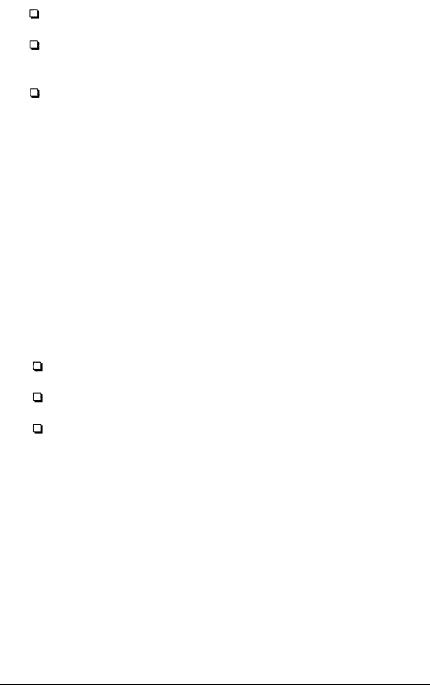
EPSON technical information library fax service
Product literature with technical specifications on EPSON’s current and new products
Customer Relations
You can purchase supplies, parts, documentation, and accessories by calling EPSON Accessories at (800) 873-7766 (U.S. only).
CompuServe@ On-line Support
The fastest way to access helpful tips, specifications, drivers, application notes, and bulletins is through the Epson America Forum on CompuServe.
If you are not currently a member of CompuServe, you are eligible for a free introductory membership as an owner of an EPSON product. This membership entitles you to:
An introductory $15 credit on CompuServe
Your own user ID and password
A complimentary subscription to CompuServe Magazine, CompuServe’s monthly publication
To take advantage of this offer, call (800) 848-8199 in the United States and Canada and ask for representative #529. In other countries, call (614) 529-1611 or your local CompuServe access number.
If you are already a CompuServe member, simply type
GO EPSON at the menu prompt to reach the Epson America Forum.
2 Getting Started

Safety Information
Laser safety
This printer is certified as a Class 1 laser product under the U.S. Department of Health and Human Services (DHHS) Radiation Performance Standard according to the Radiation Control for Health and Safety Act of 1968. This means that the printer does not produce hazardous laser radiation.
Since radiation emitted by the laser is completely confined within protective housings and external covers, the laser beam cannot escape from the machine during any phase of user operation.
CDRH regulations
The Center for Devices and Radiological Health (CDRH) of the U.S. Food and Drug Administration implemented regulations for laser products on August 2, 1976. Compliance is mandatory for products marketed in the United States. The label shown below indicates compliance with the CDRH regulations and must be attached to laser products marketed in the United States.
This Product complies with regulations 21 CFR Chapter 1, Subchapter J, section 1010, 1040.
Epson America, Inc.
20770 Madrona Ave. Tonance, CA 90503 USA
Getting Started 3
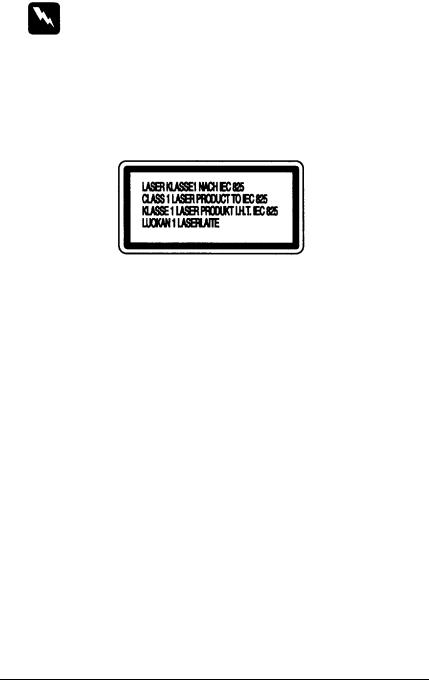
Warning:
Use of controls, adjustments, or performance of procedures other than those specified in this guide may result in hazardous radiation exposure.
Your printer is a Class 1 laser product as defined in IEC 825 specifications. The label shown below is attached in countries where required.
Internal laser radiation
Max. Radiation Power |
5mW |
Wavelength |
780 nm |
This is a Class IIIb Laser Diode Assembly that has an invisible laser beam. The printer optical unit is NOT A FIELD SERVICE ITEM. Therefore, the optical unit should not be opened under any circumstance.
Ozone emission
During printer operation, a small amount of ozone is released. This amount is not large enough to affect human beings adversely.
However, it is best to make sure the room where you are using the printer has adequate circulation, especially when you are printing a high volume of materials or using the printer continuously over a long period of time.
4 Getting Started
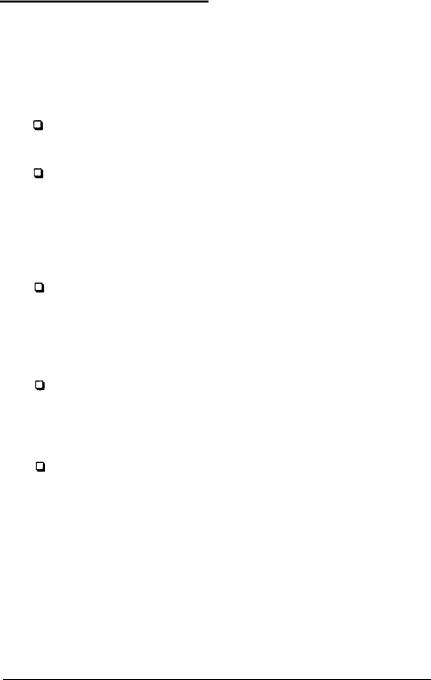
Laser Printer Precautions
This printer uses laser technology. The following list of precautions applies whenever you open the cover. Even if you are familiar with other types of printers, be sure to follow these precautions carefully to ensure safe, efficient operation.
Avoid touching the components inside the printer unless instructed to do so in this guide.
When you open the printer or remove the toner cartridge, you expose components inside the printer that can be very hot. Avoid touching the fuser area, which is located immediately above the toner cartridge when you open the front cover, and the motor, which is further inside the printer.
Do not scratch the surface of the drum, which is the green cylinder that can be seen through an opening of the toner cartridge. Avoid touching the drum, since oils from your skin can permanently damage its surface and may affect print quality.
Avoid pressing on the top of the toner cartridge. Pressing directly on the cartridge may cause toner to spill into the printer. If there is a spill, see Chapter 3 for cleaning instructions.
Never force the printer’s components into place. Although the printer is designed to be sturdy, rough handling can damage it.
Getting Started 5

The toner cartridge is the part of the printer mechanism that forms the image and transfers it onto the paper. Keep the following guidelines in mind whenever you handle the toner cartridge:
When removing the toner cartridge, avoid exposing it to room light any longer than necessary. Exposure to light can damage the drum, causing dark or light areas to appear on the printed page and reducing the service life of the drum. If you need to keep the cartridge out of the printer for long periods, cover it with a cloth.
Do not turn the cartridge upside down or stand it on its sides.
Do not attempt to modify or take apart the cartridge. It cannot be refilled.
Try not to touch the toner and avoid all contact with your eyes.
Do not use a cartridge for at least one hour after moving it from a cool to a warm environment.
To get the best print quality from your toner cartridge, do not store the cartridge in locations that are subject to direct sunlight, dust, salty air, or corrosive gasses (such as ammonia).
Also avoid locations subject to high temperatures or humidity or abrupt changes in temperature or humidity.
6 Getting Started

Important Safety Instructions
Read all of these instructions and save them for later reference. Follow all warnings and instructions marked on the printer.
Unplug the printer before cleaning. Clean with a damp cloth only. Do not spill liquid on the printer.
Do not place the printer on an unstable surface or near a radiator or heat register.
Do not block or cover the openings in the printer’s cabinet. Do not insert objects through the slots.
Use only the type of power source indicated on the printer’s label.
Connect all equipment to properly grounded power outlets. Avoid using outlets on the same circuit as photocopiers or air control systems that regularly switch on and off.
Do not let the power cord become damaged or frayed.
If you use an extension cord with the printer, make sure the total ampere rating of the devices plugged into the extension cord does not exceed the cord’s ampere rating. Also, make sure the total of all devices plugged into the wall outlet does not exceed 15 amperes.
Except as specifically explained in this Reference Guide, do not attempt to service the printer yourself.
Unplug the printer and refer servicing to qualified service personnel under the following conditions:
If the power cord or plug is damaged; if liquid has entered the printer, if the printer has been dropped or the cabinet damaged; if the printer does not operate normally or exhibits a distinct change in performance. Adjust only those controls that are covered by the operating instructions.
Getting Started 7

About this Guide
This guide contains information for operating and maintaining the printer once you have installed it. For information about installing and setting up the printer, see Read This First.
Chapter 1, “Using Your Printer,” lists the printer’s features and describes how to control the printer and load paper.
Chapter 2, “Changing the Printer Settings,” describes how to change printer settings using the Windows” printer driver. Printer driver settings allow you to do such things as change the toner density, turn on toner saving mode, and specify how long the printer is idle before it enters power save mode.
Chapter 3, “Troubleshooting,” gives helpful information for avoiding printer errors, optimizing print quality, and solving any problems you may encounter.
Appendix A contains the technical specifications about the printer.
Appendix B describes how to use the EPSON Control Panel for DOS to control the printer. This appendix is intended for users who do not have Microsoft’ Windows.
Appendix C lists the commands that can be used to control the printer. This appendix is intended for advanced users only.
Appendix D gives step-by-step instructions for installing a Single In-Line Memory Module (SIMM) so you can increase printer memory up to 5MB.
8 Getting Started

Chapter 1
Using Your Printer
About Your Printer . . . . . . . . . . . . . . . . . . . . . . . . . |
1-2 |
Features . . . . . . . . . . . . . . . . . . . . . . . . . . . . . . |
1-2 |
Adjusting the Power Save Mode . . . . . . . . . . . . . . . . . |
1-4 |
Monitoring the Printer Status . . . . . . . . . . . . . . . . . . . |
1-5 |
Front panel lights . . . . . . . . . . . . . . . . . . . . . . . . |
1-5 |
EPSON Control Panel for Windows . . . . . . . . . . . . . |
1-7 |
Paper Handling . . . . . . . . . . . . . . . . . . . . . . . . . . . |
1-8 |
Loading paper . . . . . . . . . . . . . . . . . . . . . . . . . . |
1-8 |
Choosing paper . . . . . . . . . . . . . . . . . . . . . . . . . |
1-9 |
Printing on special paper . . . . . . . . . . . . . . . . . . . |
1-10 |
Fonts . . . . . . . . . . . . . . . . . . . . . . . . . . . . . . . . . |
1-11 |
Using Your Printer |
1-1 |

About Your Printer
The ActionLaser 1100 is the latest in EPSON’s advanced line of laser printers. It emulates the Hewlett-Packard® LaserJet® III (LJ3) printer, allowing you to print using the wide variety of software programs that support HP® printers. You can control the printer from either the Windows or the MS-DOS® environment.
The printer gives you the ability to produce good-looking, professional documents and publications. Its 300-dpi resolution is enhanced by the edge smoothing feature, which smoothes jagged edges of diagonal lines in text and graphics and gives your document a clean crisp appearance.
The ActionLaser 1100 is quiet and is easy to install and use. You simply set it up and connect it to your computer as described in Read This First. To use the printer, just bring up your software program and use the Print menu option under your File menu. From the Print menu, you can access the settings that allow you to control the print job and the printer itself.
Features
The ActionLaser 1100 comes equipped with a built-in bidirectional parallel interface and with 1MB of memory, which can be expanded up to 5MB. See Appendix D for more information about installing additional memory.
The other main features are described below.
1-2 Using Your Printer

Toner saving mode
The toner saving mode allows you to reduce the amount of toner used in printing draft documents. When you turn on toner saving mode, the printer applies less toner to each page, causing text and graphics to appear gray rather than black. The toner saving mode settings allow you to control how light or dark you want the toner to be applied.
EPSON Control Panel utility
The EPSON Control Panel for Windows keeps you informed of the printer’s status and notifies you of printing errors. Each time the printer status changes, such as when the paper tray is empty or an error occurs, a message automatically appears on screen. In case of an error, the message informs you of what steps to take to clear the error.
Note:
If you are not using the printer in a Windows environment, the Reporter, which is included with the EPSON Control Panel for DOS, keeps you informed of the printer status.
Energy Star compliant
Your EPSON printer complies with the U.S. Environmental Protection Agency’s Energy Star program, which promotes the manufacture of energy-efficient printers, computers, and monitors. The printer conserves electricity by automatically entering a low-power, standby mode when not in use for a specified period of time (default is 15 minutes).
The EPA estimates that if all desktop computers, printers, and other peripheral devices met Energy Star standards, energy cost savings would exceed $1 billion annually and carbon dioxide emissions would be reduced by 20 million tons.
Using Your Printer 1-3

All of EPSON’s dot matrix and ink jet printers conform to Energy Star standards, as do all ActionLaser printers produced after June, 1993.
The Energy Star emblem dues not represent EPA endorsement of any product or service.
Optional PostScript® emulation
Optional software is available that allows you to print documents formatted for PostScript Level 2. Call your dealer or EPSON Accessories for more information.
Adjusting the Power Save Mode
In compliance with the Energy Star program, the printer enters power save mode when it is idle for a specified length of time (15 minutes by default). While in this mode, the printer conserves energy by using less electricity.
Power save mode is automatically interrupted whenever you send a print job or press the reset button at the back of the printer. It takes approximately 45 seconds for the printer to warm up when it is in power save mode.
You can specify how long the printer is idle before power save mode comes on or turn off power save mode. For more information, see Chapter 2.
1-4 Using Your Printer

Monitoring the Printer Status
If you are running Windows, the printer keeps you informed of its status in two ways:
The Ready and Error lights on the front panel come on or flash depending on the current status. For example, the Ready light begins to flash as data is sent from your computer to the printer.
The EPSON Control Panel for Windows automatically presents screens to keep you informed of the printer status or notify you of an error. For example, each time the paper tray is empty, a screen automatically appears to inform you of the change in status.
Note:
If you are running the EPSON Control Panel for DOS, the Reporter provides onscreen status and error messages to keep you informed of the printer status.
Front panel lights
The two lights on the front panel allow you to monitor the status of the printer. The green Ready light is on when the printer is on and is ready to receive print data. As data is received from the computer, the Ready light flashes.
The orange Error light indicates an error condition. If the Error light is on continuously, it indicates that no paper is loaded or that there is a paper feed jam. A flashing Error light indicates one of the following: an internal paper jam has occurred, the front cover is open, or the toner cartridge is not installed.
Using Your Printer |
1-5 |

Other status conditions are indicated by the combination of the Ready and Error lights. The following table describes all status conditions that can be indicated by the printer’s Ready and Error lights:
Ready |
Error |
Printer status |
o f f |
Off |
Printer is off. |
|
|
|
Slow |
Off |
Printer is in power save mode. |
flashing |
|
|
|
|
|
F l a s h i n g |
O f f |
Print data is being received at the printer or has |
|
|
already been received. |
|
|
|
On |
off |
Printer is ready to receive print data. |
|
|
|
off |
On |
Either the paper tray is empty or there is a |
|
|
paper feed problem. |
|
|
|
off |
Flashing |
One of the following errors has occurred: |
|
|
• Paper has jammed inside the printer. |
|
|
• The front cover is open. |
|
|
• The toner cartridge is not installed. |
|
|
|
F l a s h i n g |
O n |
One of the following errors has occurred: |
|
|
• Insufficient memory to print job. |
|
|
• Printer is In manual feed mode and is waiting |
|
|
for the next sheet. |
|
|
• There is a printer overrun error. |
|
|
|
Flashing |
Flashing |
The printer is warming up. |
|
|
|
On |
On |
A printer engine or controller error has |
|
|
occurred. Contact your dealer or a qualified |
|
|
service person. |
|
|
|
The EPSON Control Panel provides more precise information about the printer status or any errors that occur. See the next section.
1-6 Using Your Printer

EPSON Control Panel for Windows
The EPSON Control Panel for Windows consists of a series of screens that appear automatically whenever the printer status changes and whenever the printer encounters an error. For example, EPSON Control Panel messages appear in the following cases:
The paper tray is empty.
The printer is warming up.
A print error has occurred. For each error, an EPSON Control Panel message informs you of what you can do to correct the problem.
The message remains open on top of your software program until you minimize the screen by clicking the Minimize button ( ) in the upper right comer of the message window. To make the EPSON Control Panel message window reappear, double-click the EPSON Control Panel icon at the bottom left comer of your screen.
) in the upper right comer of the message window. To make the EPSON Control Panel message window reappear, double-click the EPSON Control Panel icon at the bottom left comer of your screen.
Note:
If you are using the EPSON Control Panel for DOS, the Reporter provides on screen status and error messages to keep you informed of the printer status.
Using Your Printer 1-7
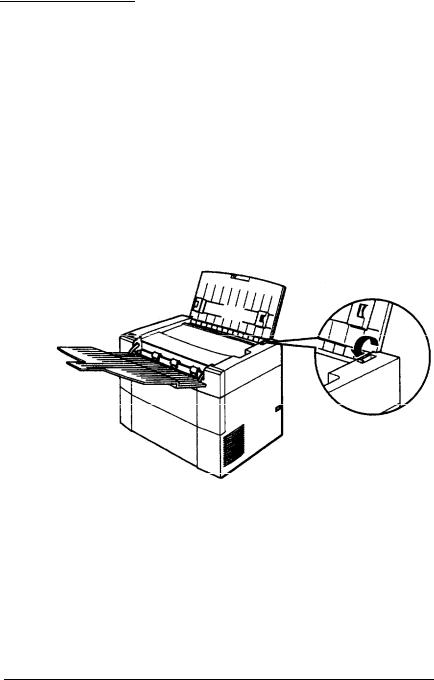
Paper Handling
The paper tray holds up to 100 sheets of various standard-size papers, including letter and legal. For other sizes and exact specifications, see Appendix A.
Loading paper
To load a stack of paper in the printer’s paper tray:
1.Remove any paper remaining in the paper tray. Do not add paper to a partial stack.
2.Pull the paper release lever toward the front of the printer.
3.Fan a stack of paper and load the paper in the paper tray. Place the paper side you want printed face down in the paper tray. Up to 100 sheets can fit in the paper tray.
4.Slide the paper guides against the paper stack so the paper fits loosely between them. The paper guides should not fit too tightly against the paper.
1-8 Using Your Printer

5.Push the paper release lever toward the back of the printer.
This places the feed roll in contact with the paper stack. Paper will not feed properly if the paper release lever is not in the feed position.
For information about loading heavy paper, envelopes, labels, or transparencies, see “Printing on special paper” later in this chapter.
Choosing paper
For best results, use paper made especially for laser printers or plain-paper copiers. Paper should be of good quality and relatively smooth with a weight between 16 and 24 lb (60 and 90 g/m²). Because the printer is sensitive to moisture, always store paper in a dry place.
You may use colored paper but not paper to which a clear or colored coating has been added. For preprinted paper stock such as letterheads, use papers and inks designed for laser printers. Ordinary inks or dyes may smear or come off when subjected to the high temperature of the fuser. Always test samples of paper stock before purchasing large amounts.
Note:
The quality of any particular brand or type of paper may be changed by the manufacturer at any time, so EPSON cannot guarantee any particular one.
In addition, you can print on special stock such as heavy paper (greater than 24 lb or 90 g/m2), envelopes, labels, or
transparencies. To do so, you need to feed single sheets one at a time. See the next section "printing on special paper.”
Using Your Printer 1-9

Printing on special paper
You can print on special paper stock such as heavy paper (over 24 lb or 90 g/m2), envelopes, labels, and transparencies. When selecting special types of paper or other stock, follow the recommendations given below.
For printing on special paper, it is usually easier to use manual feed and feed a single sheet at a time. To use manual feed, select the printer driver’s Manual Feed option and turn off Auto Continue (see Chapter 2 for information on printer driver settings). Then send your print job. The printer prints the page and then waits for you to press the reset button at the rear of the printer before it prints the next sheet.
Envelopes
Toad envelopes with the flap-side up and to the left. The printing quality on envelopes may be irregular because different parts of an envelope have different thicknesses. Print one or two envelopes to check the print quality. If the printing is too light, adjust the print density as described in Chapter 3.
Do not use envelopes with metal clasps or fastenings. Also do not use window envelopes unless they are specially designed for laser printers. The plastic on most window envelopes can melt when it comes in contact with the hot fuser.
Labels
Use only labels designed for laser printers or plain-paper copiers. To prevent the adhesive from coming into contact with printer parts, always use labels that completely cover the backing sheet, with no gaps between the individual labels. You should test the label sheet for leaking adhesive by pressing a sheet of paper on top of a sheet of labels. If the paper sticks, do not use the labels.
1-10 Using Your Printer

Transparencies
You can use overhead projector transparencies and adhesive drafting film if they are made for use with laser printers or plain-paper copiers. Normally you should use manual feed when printing transparencies.
Fonts
The printer comes with a set of 14 bitmap and 8 scalable resident fonts. The resident bitmap fonts include Courier and Line Printer in various sizes and orientations. The resident fonts, stored permanently in memory, are these:
CG Times Medium |
Univers Medium |
CG Times Bold |
Univers Bold |
CG Times Italics |
Univers Italics |
CG Times Bold Italic |
Univers Bold Italic |
All other Windows fonts are automatically transferred, or downloaded, from the computer to the printer when you send a print job. For other types of fonts to be downloaded, you need the appropriate screen font software. For example, to download Adobe® fonts, you need Adobe Type Manager™ (ATM); to download Intellifont® Scalable Typefaces from Agfa,® you need Intellifont for Windows.” If you don’t have the appropriate screen font software for a particular font, the font will not be downloaded and the printer will substitute one of the resident fonts.
Downloaded fonts remain in printer memory only until the print job is completed. When the print job is completed or you turn off the printer, downloaded fonts are flushed from memory. Downloaded fonts, which must first be transferred from the computer, do not print as fast as resident fonts.
Using Your Printer |
1-11 |

If you are printing a page that consists mainly of graphics but not a lot of TrueType text, you might want to print TrueType as graphics as described in Chapter 2. Printing TrueType fonts as graphics requires less printer memory and may speed up printing because the fonts don’t need to be downloaded. Printing TrueType as graphics is also useful if you want to print graphics over text so that only a portion of the text is visible.
1-12 Using Your Printer
